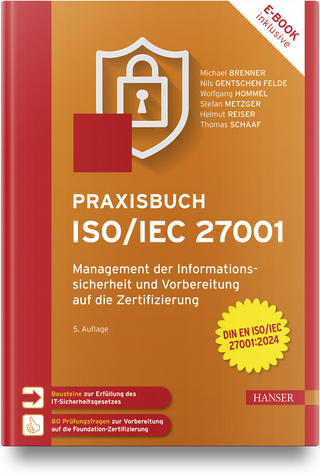
Privileged Attack Vectors
Apress (Verlag)
978-1-4842-5913-9 (ISBN)
In decades past, an entire enterprise might be sufficiently managed through just a handful of credentials. Today’s environmental complexity has seen an explosion of privileged credentials for many different account types such as domain and local administrators, operating systems (Windows, Unix, Linux, macOS, etc.), directory services, databases, applications, cloud instances, networking hardware, Internet of Things (IoT), social media, and so many more. When unmanaged, these privileged credentials pose a significant threat from external hackers and insider threats. We are experiencing an expanding universe of privileged accounts almost everywhere.
There is no one solution or strategy to provide the protection you need against all vectors and stages of an attack. And while some new and innovative products will help protect against or detect against a privilege attack, they are not guaranteed to stop 100% of malicious activity. The volume and frequency of privilege-based attacks continues to increase and test the limits of existing security controls and solution implementations.
Privileged Attack Vectors details the risks associated with poor privilege management, the techniques that threat actors leverage, and the defensive measures that organizations should adopt to protect against an incident, protect against lateral movement, and improve the ability to detect malicious activity due to the inappropriate usage of privileged credentials.
This revised and expanded second edition covers new attack vectors, has updated definitions for privileged access management (PAM), new strategies for defense, tested empirical steps for a successful implementation, and includes new disciplines for least privilege endpoint management and privileged remote access.
What You Will Learn
Know how identities, accounts, credentials, passwords, and exploits can be leveraged to escalate privileges during an attack
Implement defensive and monitoring strategies to mitigate privilege threats and risk
Understand a 10-step universal privilege management implementation plan to guide you through a successful privilege access management journey
Develop a comprehensive model for documenting risk, compliance, and reporting based on privilege session activity
Who This Book Is For
Security management professionals, new security professionals, and auditors looking to understand and solve privilege access management problems
Morey J. Haber is Chief Technology Officer at BeyondTrust. He has more than 20 years of IT industry experience, and has authored three Apress books: Asset Attack Vectors and Identity Attack Vectors, as well as the first edition of Privileged Attack Vectors. He joined BeyondTrust in 2012 as a part of the eEye Digital Security acquisition. He currently oversees BeyondTrust technology management solutions for vulnerability, and privileged and remote access. In 2004, he joined eEye as Director of Security Engineering and was responsible for strategic business discussions and vulnerability management architectures in Fortune 500 clients. Prior to eEye, he was Development Manager for Computer Associates, Inc. (CA), responsible for new product beta cycles and named customer accounts. He began his career as Reliability and Maintainability Engineer for a government contractor building flight and training simulators. He earned a Bachelor of Science degree in Electrical Engineering from the State University of New York at Stony Brook.
Chapter 1: Privileged Attack Vectors.- Chapter 2: Privileges.- Chapter 3: Credentials.- Chapter 4: Attack Vectors.- Chapter 5: Passwordless Authentication.- Chapter 6: Privilege Escalation.- Chapter 7: Insider and External Threats.- Chapter 8: Threat Hunting.- Chapter 9: Unstructured Data.- Chapter 10: Privileged Monitoring.- Chapter 11: Privileged Access Management.- Chapter 12: PAM Architecture.- Chapter 13: Break Glass.- Chapter 14: Industrial Control Systems (ICS) and Internet of Things (IoT).- Chapter 15: The Cloud.- Chapter 16: Mobile Devices.- Chapter 17: Ransomware and Privileges.- Chapter 18: Remote Access.- Chapter 19: Secured DevOps (SecDevOps).- Chapter 20: Regulatory Compliance.- Chapter 21: Just in Time.- Chapter 22: Zero Trust.- Chapter 23: Sample Privileged Access Management Use Cases.- Chapter 24: Deployment Considerations.- Chapter 25: Privileged Account Management Implementation.- Chapter 26: Machine Learning.- Chapter 27: Conclusion.-
| Erscheinungsdatum | 30.06.2020 |
|---|---|
| Zusatzinfo | 40 Illustrations, color; XXXV, 384 p. 40 illus. in color. |
| Verlagsort | Berkley |
| Sprache | englisch |
| Maße | 155 x 235 mm |
| Themenwelt | Informatik ► Netzwerke ► Sicherheit / Firewall |
| Schlagworte | Administrator • cybersecurity • cyber threat • Exploits • Information Security • Infosec • Lateral Movement • Least Privileged • PAM • Password Management • Privileged Access Management • Privileged Escalation • Root • Session Management • Vulnerabilities |
| ISBN-10 | 1-4842-5913-0 / 1484259130 |
| ISBN-13 | 978-1-4842-5913-9 / 9781484259139 |
| Zustand | Neuware |
| Informationen gemäß Produktsicherheitsverordnung (GPSR) | |
| Haben Sie eine Frage zum Produkt? |
aus dem Bereich


